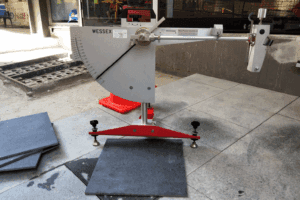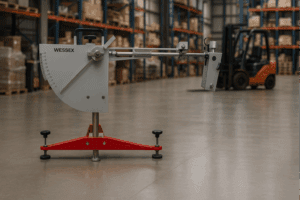Shiny Doesn’t Equal Safe: Why You Still Need a Slip Test
A high-gloss finish might look premium—but it says nothing about how safe the surface really is underfoot.
Too often, building managers, suppliers, or even specifiers assume that a polished floor is compliant or “safe enough.” But visual appeal is not a substitute for performance. In fact, polishing, sealing, or coating a surface can reduce its slip resistance—sometimes significantly, particularly when water, cleaning residues, or oils are present.
The result? A floor that looks impressive but becomes a serious liability in wet or transitional areas.
The Risk Behind the Shine
Most people judge slip risk visually or by instinct: if it looks rough, it must be safe; if it’s smooth and clean, it must be compliant. Unfortunately, that logic fails under scientific scrutiny. Many sealers, coatings, and finishes alter a floor’s surface friction—sometimes pushing it below the minimum thresholds required by the National Construction Code or relevant Australian Standards.
These changes aren’t always visible. A freshly sealed surface may look identical to an untreated one but deliver far lower performance under a wet pendulum test.
The Only Way to Know: Test
If a floor has the potential to become slippery when wet—due to cleaning, weather, or usage—it should be tested.
For new surfaces, testing should follow AS 4586:2013
For existing surfaces, the relevant method is AS 4663:2013
These are the standards accepted by certifiers, insurers, and courts. A visual inspection alone won’t hold up in the event of a claim.
Testing also provides clarity for maintenance teams. It allows facilities to track how coatings, wear, or cleaning practices are affecting surface safety over time—and act before a problem becomes a fall.
Look Sharp, Stay Compliant
A well-finished floor can—and should—look great. But performance matters more than polish. If there’s any doubt about a floor’s true slip resistance, don’t rely on how it looks. Test it, document it, and reduce your risk.
Looks good? Great. Still test.
Don’t Let Appearance Be Your Risk Strategy
Visual inspections won’t hold up in court. Whether you’re managing new floors or maintaining existing ones, a certified slip test gives you the facts—before someone slips.
Explore more

Colour, Grit and Surface Finish: How Subtle Differences Change Slip Ratings (AS 4586:2013)
Colour, grit and finish change slip resistance. Learn why P-ratings vary across tile ranges and coatings

Why One Slip Test Isn’t Enough for Product Lines (AS 4586:2013)
Slip resistance varies across colours and finishes. Learn why one AS 4586 test cannot certify an entire product line.

Industrial Slip Resistance: Dust, Boots & Coating Drift (AS 4663:2013)
: Industrial floors change fast. Learn how dust, coatings and machinery reduce slip resistance and why AS 4663 onsite testing is essential.
Stay Ahead of Safety Standards
Join the Zerofal newsletter for actionable insights on slip testing, compliance updates, and smart prevention strategies. No spam – just practical safety advice.
